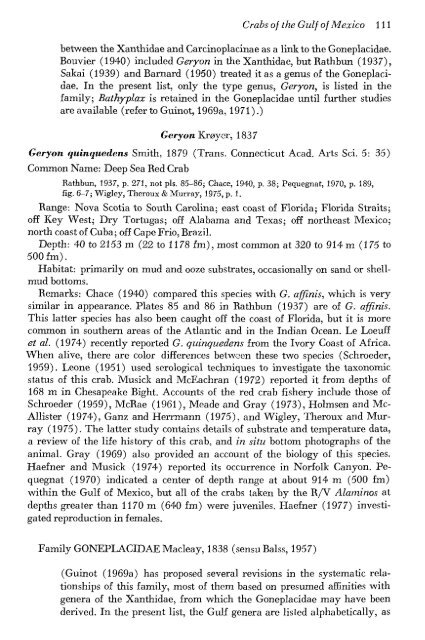You also want an ePaper? Increase the reach of your titles
YUMPU automatically turns print PDFs into web optimized ePapers that Google loves.
Crabs of the Gulf of Mexico 111<br />
between the Xanthidae and Carcinoplacinae as a link to the Goneplacidae.<br />
Bouvier (1940) included Geryon in the Xanthidae, but Rathbun (1937),<br />
Sakai (1939) and Barnard (1950) treated it as a genus of the Goneplacidae.<br />
In the present list, only the type genus, Geryon, is listed in the<br />
family; Bathyplax is retained in the Goneplacidae until further studies<br />
are available (refer to Guinot, 1969a, 1971).)<br />
Geryon Kreyer, 183 7<br />
Geryon quinquedens Smith, 1879 (Trans. Connecticut Acad. Arts Sci. 5: 35)<br />
Common Name: Deep Sea Red Crab<br />
Rathbun, 1937, p. 271, not pis. 85-86; Chace, 1940, p. 38; Pequegnat, 1970, p. 189,<br />
fig. 6-7; Wigley, Theroux & Murray, 1975, p. 1.<br />
Range: Nova Scotia to South Carolina; east coast of Florida; Florida Straits;<br />
off Key West; Dry Tortugas; off Alabama and Texas; off northeast Mexico;<br />
north coast of Cuba; off Cape Frio, Brazil.<br />
Depth: 40 to 2153 m (22 to 1178 fm), most common at 320 to 914 m (175 to<br />
500 fm).<br />
Habitat: primarily on mud and ooze substrates, occasionally on sand or shellmud<br />
bottoms.<br />
Remarks: Chace (1940) compared this species with G. affinis, which is very<br />
similar in appearance. Plates 85 and 86 in Rathbun (1937) are of G. affinis.<br />
This latter species has also been caught off the coast of Florida, but it is more<br />
common in southern areas of the Atlantic and in the Indian Ocean. Le Loeuff<br />
et al. (1974) recently reported G. quinquedens from the Ivory Coast of Africa.<br />
When alive, there are color differences between these two species (Schroeder,<br />
1959). Leone (1951) used serological techniques to investigate the taxonomic<br />
status of this crab. Musick and McEachran (1972) reported it from depths of<br />
168 m in Chesapeake Bight. Accounts of the red crab fishery include those of<br />
Schroeder (1959), McRae (1961), Meade and Gray (1973), Holmsen and Mc<br />
Allister (1974), Ganz and Herrmann (1975), and Wigley, Theroux and Murray<br />
(1975). The latter study contains details of substrate and temperature data,<br />
a review of the life history of this crab, and in situ bottom photographs of the<br />
animal. Gray (1969) also provided an account of the biology of this species.<br />
Haefner and Musick (1974) reported its occurrence in Norfolk Canyon. Pequegnat<br />
(1970) indicated a center of depth range at about 914 m (500 fm)<br />
within the Gulf of Mexico, but all of the crabs taken by the R/V Alaminos at<br />
depths greater than 1170 m (640 fm) were juveniles. Haefner (1977) investigated<br />
reproduction in females.<br />
Family GONEPLACIDAE Macleay, 1838 (sensuBalss, 1957)<br />
(Guinot (1969a) has proposed several revisions in the systematic relationships<br />
of this family, most of them based on presumed affinities with<br />
genera of the Xanthidae, from which the Goneplacidae may have been<br />
derived. In the present list, the Gulf genera are listed alphabetically, as

















